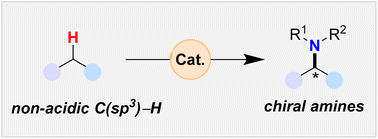Recent developments for intermolecular enantioselective amination of non-acidic C(sp3)–H bonds
Abstract
Enantioenriched chiral amines are of exceptional importance in the pharmaceutical industry. Recently, several new methods for the installation of these functional groups directly from non-acidic C(sp3)–H bonds by catalytic intermolecular enantioselective amination have been reported. These methods represent significant advances of the field and most of them display high levels of enantioselectivity, utilize the C(sp3)–H substrate as the limiting reagent, feature good functional group tolerance, and show compatibility with late-stage C(sp3)–H amination of advanced substrates. This perspective provides an overview of the recent developments in this rapidly advancing field and outlines possibilities and limitations, which will help identify unsolved challenges and guide future research efforts.

- This article is part of the themed collections: Most popular 2023 catalysis articles, 2023 Chemical Science Perspective & Review Collection and #MyFirstChemSci 2023


 Please wait while we load your content...
Please wait while we load your content...